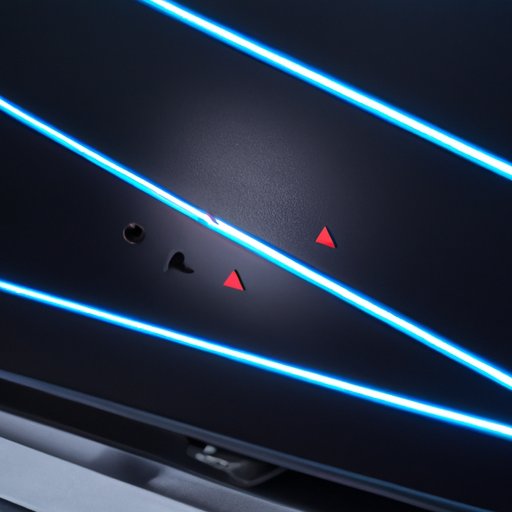Introduction
If you’ve ever experienced a flickering computer monitor, you know how frustrating it can be. It not only causes eye strain and headaches but can also affect your productivity. In this article, we’ll go over the common causes of monitor flickering, troubleshooting tips, preventative measures, and the advancements in monitor technology. We’ll also provide a review of popular monitor brands and recommendations for reliable ones.
Investigate Common Causes of Monitor Flickering
Flickering on your computer monitor can be caused by various factors. Here we’ll look at the most common causes:
Outdated drivers
Outdated graphics drivers can cause monitor flickering. Ensure that your graphics card drivers are up to date.
Damaged cable
A damaged cable can cause flickering. Check if there are any visible physical damages to the cable.
Malfunctioning graphics card
A malfunctioning graphics card can cause flickering. If updating drivers and checking the cable do not solve the issue, the graphics card might need to be replaced.
Broken backlight
A broken backlight can cause flickering. Check for any visible signs of damage on the monitor.
Loose connections
Loose connections can cause flickering. Check that all the cables are securely plugged in.
Overheating
Overheating can cause flickering. Ensure that your monitor is properly ventilated and not obstructed.
Too high or low refresh rate
If your monitor refresh rate is too high or low, it can cause flickering. Ensure that your monitor refresh rate matches your graphics card and computer settings.
Troubleshooting Tips for Fixing Monitor Flickering
If you’re experiencing a flickering monitor, there are a few actions you can take to try and fix the issue.
Updating drivers
Ensure that your graphics card drivers are up to date. You can do this by checking the manufacturer’s website for the latest drivers.
Checking cables and connections
Ensure that all the cables are properly plugged in and that there are no visible physical damages to the cables.
Adjusting refresh rate
Ensure that your monitor refresh rate matches your graphics card and computer settings.
Removing interferences
Remove any sources of electromagnetic interference near the monitor.
Running malware scans
Run malware scans to ensure that there are no viruses affecting your monitor or computer.
Replacing broken parts
If the flickering persists, there might be a broken part that needs to be replaced. In this case, seek professional help if you’re unsure how to do it yourself.
Monitor Maintenance to Prevent Flickering
Maintenance is critical in ensuring that your computer monitor is always in good condition. Here are some tips:
Cleaning the monitor screen
Clean the monitor screen regularly to prevent dust build-up. Use a microfiber cloth to avoid scratches.
Cleaning the cooling fan
Clean the cooling fan regularly to ensure that it’s working correctly.
Checking for loose connections
Check that all cables are securely plugged in and that there are no visible physical damages to them.
Keeping the monitor in a cool temperature
Ensure that your monitor is not exposed to extreme temperatures, which can cause damage to the monitor.
Avoiding direct sunlight
Avoid exposing your monitor to direct sunlight, which can cause it to overheat.
Turning off the monitor when not in use
Turning off the monitor when not in use can help prolong the monitor’s lifespan and prevent flickering issues.
Monitor Technology Advancements
Monitor technology has advanced to offer better features and reduced flickering. One of the most significant advancements is the LED backlight technology.
Explanation of LED backlighting technology
LED backlighting utilizes light-emitting diodes as light sources to produce vivid and brighter colors. It is energy-efficient and provides more consistent lighting than traditional CCFL backlights.
Benefits of using LED backlighting
The primary benefit of using LED backlighting is that it reduces flickering and eye strain, which is common in traditional backlights.
How monitor technology has improved to solve flickering problems
Manufacturers have addressed monitor flickering issues by reducing the refresh rate, enhancing the backlight technology, using anti-glare screens, and reducing blue light emission.
Preventative Measures
Preventative measures are simple actions that can help reduce the chances of monitor flickering issues.
Avoiding extreme temperatures
Avoid exposing your monitor to extreme temperatures to prevent damage to the monitor.
Proper handling of monitor cables
Proper handling of monitor cables can prevent damage to them, leading to flickering issues.
Proper handling of the monitor itself
Handle the monitor with care to prevent physical damages that can cause flickering.
Monitor Brands Analysis
We’ve researched and analyzed popular monitor brands to find the most reliable ones.
Comparison of reliability and quality
We compared several factors, including reliability, quality, warranty, cost, and customer satisfaction.
Recommendations for reliable brands
Based on our research, Dell and Asus monitors are the most reliable brands to consider.
Conclusion
In conclusion, monitor flickering can be frustrating and affect your productivity. We’ve provided an overview of common causes, troubleshooting tips, preventative measures, advancements in monitor technology, and reliable monitor brands. It’s always essential to keep your computer monitor in good condition to avoid future flickering issues. We encourage you to take the necessary steps to ensure your monitor is always in proper working order.
